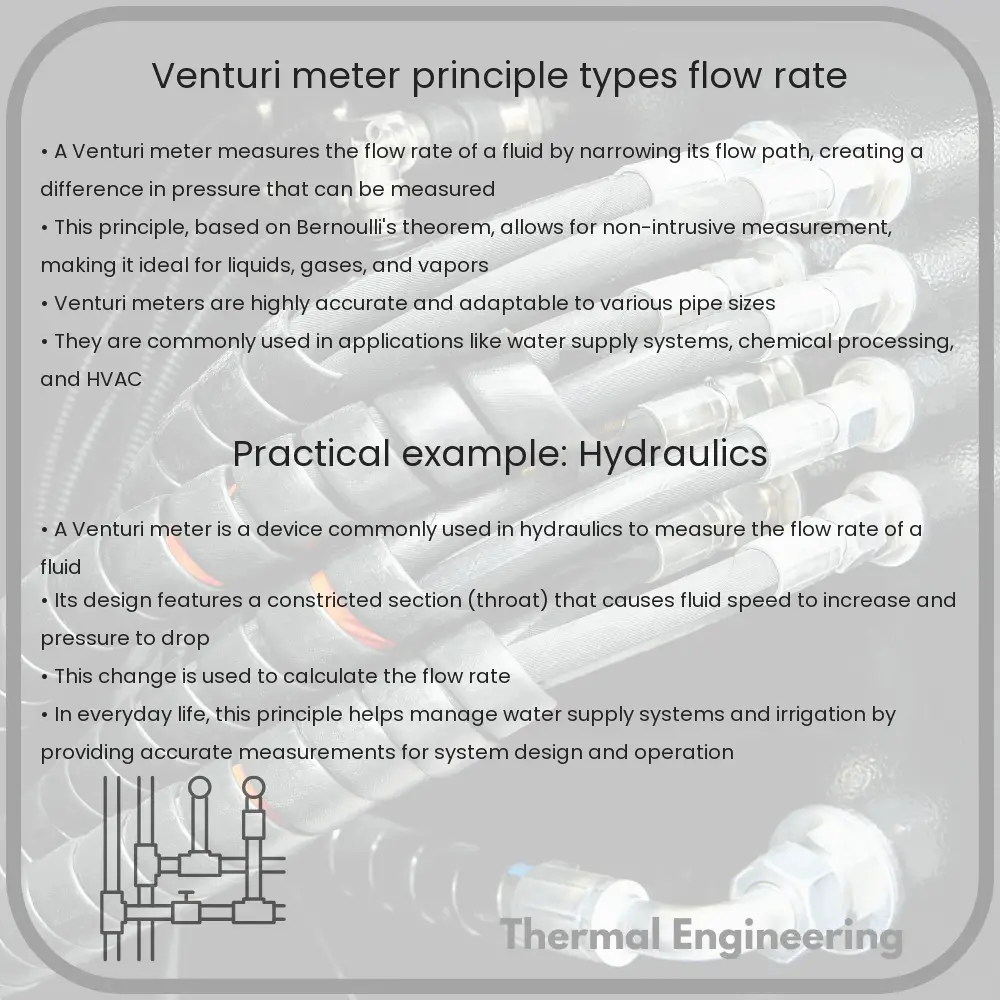Learn about the Venturi meter, a device used to measure fluid flow rate in pipes based on the Venturi Effect and Bernoulli’s Principle.

Understanding the Venturi Meter: Principle, Types, and Calculating Flow Rate
A Venturi meter is a device commonly used to measure the flow rate of a fluid in a pipe. It operates on a simple yet elegant principle derived from Bernoulli’s Equation and the Continuity Equation. This article explores the underlying principles of the Venturi meter, its various types, and how it is used to calculate the flow rate of a fluid.
Principle of Operation
The Venturi meter utilizes the Venturi Effect, an application of Bernoulli’s Principle, which states that an increase in the speed of a fluid occurs simultaneously with a decrease in pressure or potential energy of the fluid. The meter features a constricted section or ‘throat’ which forces the fluid to increase velocity and subsequently decrease its pressure. This change in pressure is the key to measuring the flow rate.
Mathematically, the principle can be supported by Bernoulli’s Equation:
p1 + 0.5*ρ*v12 + ρgh1 = p2 + 0.5*ρ*v22 + ρgh2
Here, p indicates the pressure, ρ is the fluid density, v represents velocity of the fluid, g is acceleration due to gravity, and h is the height at respective points 1 and 2.
Combined with the Continuity Equation:
A1*v1 = A2*v2
where A is the cross-sectional area of the flow, this principle allows the venturi meter to calculate the flow rate.
Types of Venturi Meters
There are several types of Venturi meters which range in design to suit different applications:
- Classic Venturi Tube: Features a gradually narrowing entrance and a longer throat.
- Short Tube Venturis: Offers a shorter build by having a shorter throat and a rapid expansion in the divergence section.
- Insert Type Venturi: Designed for easy installation in existing pipe systems, usually with a cylindrical entry followed by a conical converging section.
Calculating Flow Rate
To calculate the flow rate using a Venturi meter, one can use the simplified version of Bernoulli’s Equation resultant from measurements taken directly by the device:
Q = C*A2*√((2*ΔP)/ρ)
Where:
Qis the volumetric flow rateCis the discharge coefficient, accounting for fluid dynamics not captured in the ideal equationA2is the area of the throatΔPis the pressure differential between the upstream and throatρis the density of the fluid
This formula enables users to obtain a direct measurement of the fluid’s flow rate by observing the pressure difference, which the device can measure accurately.
Conclusion
The Venturi meter remains a favored choice for non-invasive flow rate measurement in various fluids due to its simplicity, reliability, and accuracy. Understanding its operating principles, types available, and calculation methods can help users in engineering to accurately monitor and control fluid dynamics in systems.